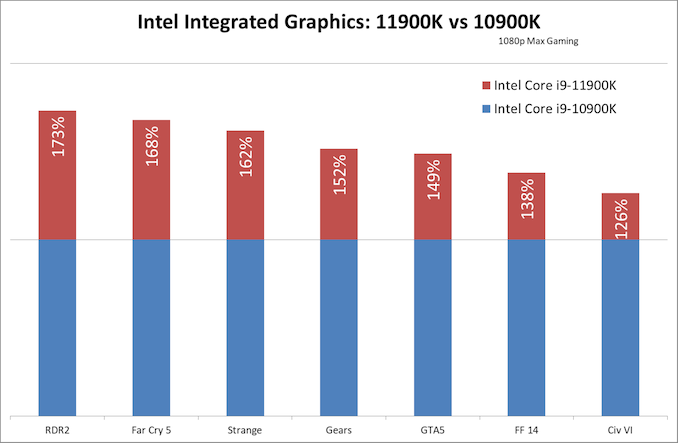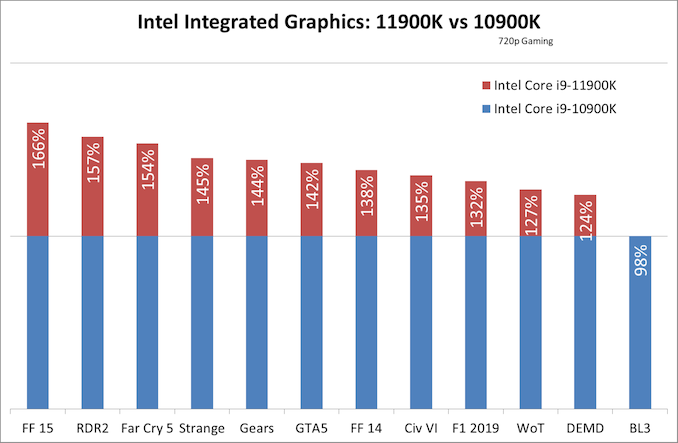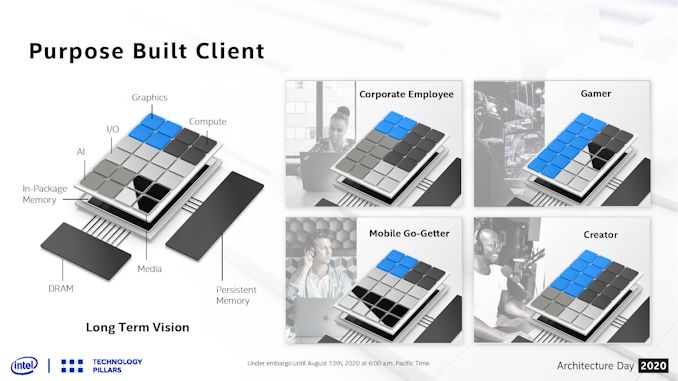Intel’s Integrated Graphics Mini-Review: Is Rocket Lake Core 11th Gen Competitive?
by Dr. Ian Cutress on May 7, 2021 10:20 AM ESTConclusions
No-one ever said that integrated graphics solutions had to be good. Nonetheless there is always the desire for something better, something higher performance, and something suitable for end-users. At the beginning of the era of integrated graphics, the focus was on simply providing something basic for 2D work - applications on an operating system and no real graphics rendering to mention. That solution is simple enough, however the demand on integrated graphics has grown over time, especially as the demands we put on our devices have also grown.
A modern system, especially a commercial system or one designed for work, has to do it all. Anyone not working in graphics might depend on a integrated solution to navigate complex arty web interfaces for the tool they use, or rely upon the acceleration features now baked into those platforms. Also perhaps, from time to time, some mild gaming use as well, if not outright using the compute features of the graphics for transcoding or AI. These demands are most heavily focused on mobile platforms, and as a result mobile platforms from Intel tend to get the best integrated graphics solutions, especially in thin-and-light designs where a discrete graphics solution is too power hungry. Intel's mobile Tiger Lake-U series offers a sizeable 96 execution units of the latest generation graphics architecture, compared to the desktop processors we are testing today, that only have 32.
So what use is a desktop processor with integrated graphics?
AMD and Intel both have product lines with integrated graphics. From Intel, its integrated graphics is in almost everything that Intel sells for consumers. AMD used to be that way in the mid-2010s, until it launched Ryzen, and now we have separate CPU-only and CPU+Graphics options. This is where the company philosophy differs.
AMD's desktop processors with integrated graphics are primarily intended to be a whole system replacement, with users relying on the integrated graphics for all their graphics needs. As a result AMD puts a lot more processing hardware into its integrated graphics solutions for the desktop, and it results in a good gaming experience for entry level gaming.
Intel's route on the otherhand is a bit more basic. The desktop integrated graphics here has two main directions: first, as the basic graphics needed for an office system, or second, more of a fall-back option for when the discrete card doesn't work or fails in more premium desktop systems. The power isn't there for hardcore grunt like gaming of any serious note, but it is certainly enough to cover the basics.
Despite this, with the new Xe-LP graphics solution, Intel has some aces up its sleeve. First is AV1 decoding, which allows users to watch AV1 content without putting stress on the CPU. Second is video encoding accelerationt through QuickSync, which has actually been a part of Intel's graphics for a number of years. Third is a relatively new feature: Intel's 'additional processor' mentality. Normally when a system has a discrete graphics card, the integrated graphics is disabled. But now, with its latest mobile devices for example, when Intel pairs its mobile processor with integrated graphics with a second graphics solution at about the same performance, with the right software Intel allows both graphics to work asynchrouusly on two different problems. The limit to this in the past has been dictating which graphics is the video out rather than simply a compute accelerator, but Intel believes it has worked it out. However, this is relatively little use for gaming, the topic of today.
Results Summary
In this review, we highlighted that Intel has now implemented its new Xe-LP graphics architecture onto its desktop processor line, and tested the new solutions against our traditional CPU gaming test suite. What we saw, in terms of a generational uplift from the i9-10900K to the i9-11900K, is actually quite impressive:
In our 720p testing, there's a clear generational gain across the board for Rocket Lake, and in most cases the games become a lot more playable. The average gain is 39%. If we flip to our gaming results at the higher resolution and settings:

Games with under 10 FPS across the board are left out
For these titles, the average gain is 153%, showing that Xe-LP is certainly a step up regardless of the workload.
The Future of Integrated Graphics
A key talking point about integrated graphics is whether a company should leverage a strong CPU product at the expense of graphics, or aim for something with strong integrated graphics as a more complete chip at the expense of the mid-range graphics market. The console market for example relies fully on integrated graphics designs, especially as it keeps the manufacturing simpler and number of chips lower. But on the desktop space, because discrete graphics are an option (well, when we're not in a mining craze or semiconductor shortage), there seems to be no impetus for companies to do a full fat integrated graphics solution that competes on the same stage as a mid-range graphics card. AMD could do it, but it might overlap with their console agreements, and Intel hasn't done anything serious since Broadwell.
To put a nod to Broadwell, Intel's 5th Gen processor. It was so powerful at integrated graphics at the time, we are still using it today as a comparison point when comparing against other Intel solutions. Broadwell had dedicated 48% of the die area of its top processor to graphics, and for that product it also added some really fast cache memory as well. Intel's focus on integrated graphics as a function of die size has decreased over time, now with Rocket Lake sits at around 20% of the silicon. It hasn't been this low since Intel first introduced its integrated graphics solutions. For that 20%, we get 32 execution units with eight processing cores. Tiger Lake has 96 EUs which total around 33% of overall die size, but has four cores. If Intel was focused on graphics performance in the same way as it was in Broadwell, we might be looking at a 256+ EU solution.
With Intel taking a renewed approach to graphics with its Xe portfolio, stemming from entry up to high performance compute, there is room here for Intel to develop integrated graphics focused solutions. Intel has detailed that it is moving to chiplets with its future mainstream processors under its 'Client 2.0' strategy, and part of that is allowing customers to select how many IP blocks they want of cores, IO, memory, security, and graphics. In the image above, the Gamer option has half of the die area for graphics. This could at the end of the day be a target that could see Intel making desktop integrated graphics a focus again.












165 Comments
View All Comments
GeoffreyA - Saturday, May 8, 2021 - link
On Twitter, he posts a "Happy New Year" and retweets some Apple things, but other than that, nothing much. I do recall one message saying, he was happy and couldn't complain.Hulk - Friday, May 7, 2021 - link
Beyond hardware video decode I was referring to the OpenCL accelerated video filters Vegas Pro uses to make previewing smooth. Rendering isn't a big deal as I can frameserve a project to Handbrake and transcode overnight. But smooth previews during the editing process are essential for creative on-the-fly work.brucethemoose - Saturday, May 8, 2021 - link
Ahhh, yeah, that's very different. Some sites like Pudget bench the GPU filters, but I'm not sure how well that translates to preview performance, and they don't do IGPs.mode_13h - Friday, May 7, 2021 - link
It'd have been nice if you'd bothered to look up the EU-counts for the earlier CPUs. Here they are:Sandy Bridge i7-2600K Jan 2011 4 Gen6 12 EU 11%
Ivy Bridge i7-3770K April 2012 4 Gen7 16 EU 29%
Haswell i7-4770K June 2013 4 Gen7.5 20 EU 29%
Broadwell i7-5775C June 2015 4 Gen8 48 EU 48%
Skylake i7-6700K Aug 2015 4 Gen9 24 EU 36%
Kaby Lake i7-7700K Jan 2017 4 Gen9 24 EU 36%
Coffee Lake i7-8700K Sept 2017 6 Gen9 24 EU 30%
Coffee Lake i9-9900K Oct 2018 8 Gen9 24 EU 26%
mode_13h - Friday, May 7, 2021 - link
I knew the formatting wouldn't look great, but that's a mess. It kept only one space between words!Here's a simplified table, with the full list:
i7-2600K 12 EUs
i7-3770K 16 EUs
i7-4770K 20 EUs
i7-5775C 48 EUs
i7-6700K 24 EUs
i7-7700K 24 EUs
i7-8700K 24 EUs
i9-9900K 24 EUs
i9-10900K 24 EUs
i9-11900K 32 EUs
Mobile CPUs:
i7-1065G7 64 EUs
i7-1185G7 96 EUs
mode_13h - Friday, May 7, 2021 - link
Note that Broadwell's GT2's mostly had 24 EUs, but that's one of the models with GT3e graphics.mode_13h - Friday, May 7, 2021 - link
Of course, the EU-count doesn't tell the full story. One of the more notable changes was in Gen 7, when they went from 1x 128-bit SIMD to 2x.WaltC - Friday, May 7, 2021 - link
I'm sort of perplexed--I didn't see that the title question was answered in the article...unless Dr. Potato Head is asking whether Intel's current IGPs are "competitive" with older Intel IGPs...which would seem to be the case. I mean, we should hope that Intel's latest should best its previous efforts. But is that really being "competitive"...? Intel seems very confused of late as to who its chief competitor is, imo--at least publicly...;)Oxford Guy - Friday, May 7, 2021 - link
I’m confused by your reference to a child’s game.29a - Friday, May 7, 2021 - link
I'm guessing it's because the Dr has a YouTube channel called Tech Potato or something close to that and he calls low end computers potatoes.